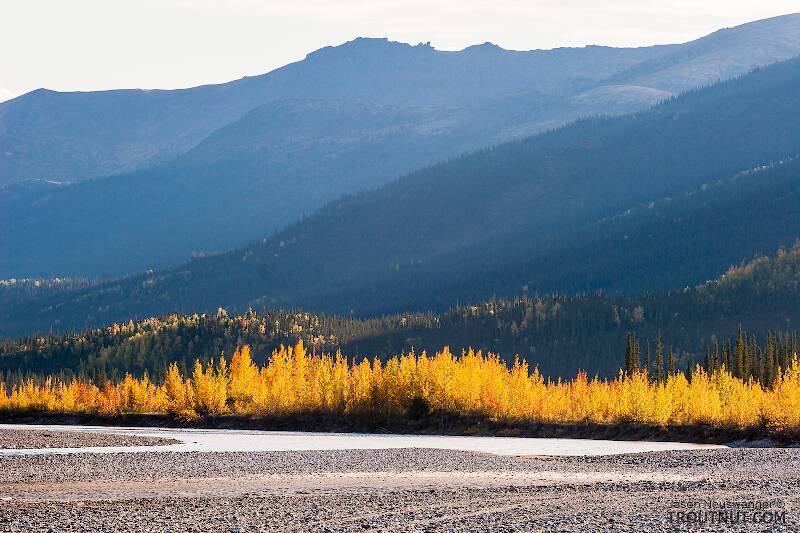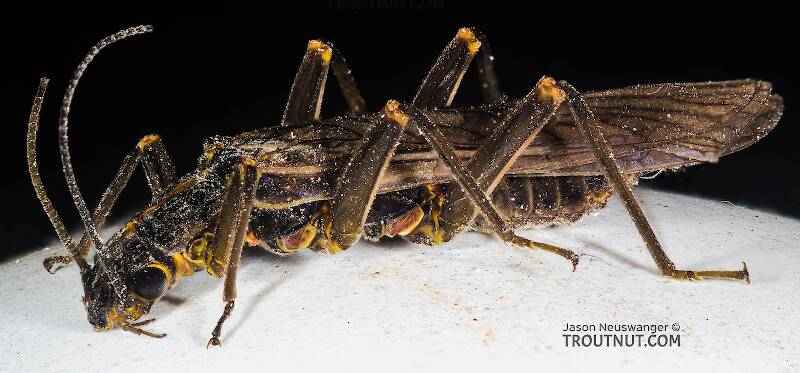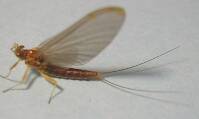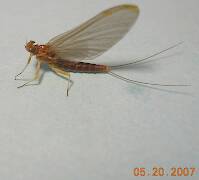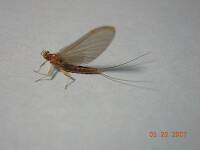
Salmonflies
Pteronarcys californica
The giant Salmonflies of the Western mountains are legendary for their proclivity to elicit consistent dry-fly action and ferocious strikes.
Featured on the forum

Troutnut is a project started in 2003 by salmonid ecologist Jason "Troutnut" Neuswanger to help anglers and
fly tyers unabashedly embrace the entomological side of the sport. Learn more about Troutnut or
support the project for an enhanced experience here.
Martinlf on May 27, 2007May 27th, 2007, 10:13 am EDT
With me being a stubborn one fly guy, the two-fly rig has not in the past been favored, but following the sage advice of others I trust, this year I've tried it more often during the sulphur hatch. It worked on a stubborn fish that would not take an emerger along with his buddies. A nymph dropped from the bend took him on the first try. Then when sulphurs came off at dusk and lasted well after dark recently a white winged snowshoe emerger with a sulphur wet dropped from the bend allowed me to see some of the takes on both flies, and when I couldn't see the white wing anymore fish still took them. A heavy spinner fall the next night left me fishless, though, with this rig. They wanted the spent fies. Here's what I wish I'd fished, a suggestion from Bill Anderson of the Little Juniata River Association: a big cahill with a sulphur spinner tied 12-18 inches back on a bend dropper. Next time. Have others tried the two-fly rig? I must admit they do tangle wickedly at times, but they generally treated me kindly this year.
"He spread them a yard and a half. 'And every one that got away is this big.'"
--Fred Chappell
--Fred Chappell
Shawnny3 on May 27, 2007May 27th, 2007, 12:34 pm EDT
I almost always fish two (or, when truly desperate, three) flies at a time. It sounds like you have found a few very good options for doing so, Louis, and clearly you have gotten the hang of it. I have started attaching my flies closer together, allowing me better control in seams where fast and slow water meet. When I rig two flies, I usually do so with flies of widely varying size and color - if I really want to fish a size-14 dark sulphur nymph, for example, I might fish it along with a size-20 BWO emerger. Even during obvious hatches, I usually only go to a single fly if it is being taken to the exclusion of all else. I've learned that the "obvious" hatch might not always be the only thing going on.
Using the bushy white dry as an indicator for a less visible fly is an excellent idea, not just in low light during spinner falls but also when fishing midge or trico hatches - any type of fly that's hard to see.
Dropping the nymph from the dry is a nice idea. Remember when you do this that you don't necessarily have to fish the rig as you normally would fish a dry. Besides concentrating on getting good dry-fly presentations, you can also be actively fishing the nymph and using the dry strictly as an indicator. I won't say any more than that because I'd like to leave a bit to the reader's imagination, but I've done some very stealthy nymphing with this type of rig when I can think of no other good way to present a nymph to a certain lie.
To keep flies from tangling, you must be more aware with this type of rig of any slack in your line, both while you're casting and when you're not. You must keep at least slight tension on the line all the time. Also, fishing the lighter of your flies as the trailing fly helps the rig roll over properly, as opposed to rigging with the heavier fly trailing.
-Shawn
Using the bushy white dry as an indicator for a less visible fly is an excellent idea, not just in low light during spinner falls but also when fishing midge or trico hatches - any type of fly that's hard to see.
Dropping the nymph from the dry is a nice idea. Remember when you do this that you don't necessarily have to fish the rig as you normally would fish a dry. Besides concentrating on getting good dry-fly presentations, you can also be actively fishing the nymph and using the dry strictly as an indicator. I won't say any more than that because I'd like to leave a bit to the reader's imagination, but I've done some very stealthy nymphing with this type of rig when I can think of no other good way to present a nymph to a certain lie.
To keep flies from tangling, you must be more aware with this type of rig of any slack in your line, both while you're casting and when you're not. You must keep at least slight tension on the line all the time. Also, fishing the lighter of your flies as the trailing fly helps the rig roll over properly, as opposed to rigging with the heavier fly trailing.
-Shawn
Jewelry-Quality Artistic Salmon Flies, by Shawn Davis
www.davisflydesigns.com
www.davisflydesigns.com
Martinlf on May 28, 2007May 28th, 2007, 6:34 am EDT
Great suggestions, Shawn, though I'm going to beg for a little more detail about actively fishing the nymph below the dry, if you will help my weak imagination along some. And just how close will you fish the two flies? Several folks have suggested about 18 inches, but I'm more comfortable with closer (especially with two dries) unless I want a dropped fly underwater and nearer the bottom. Also, did you see Jason, and how did things go for him? I'm hoping he had some luck in Happy Valley.
"He spread them a yard and a half. 'And every one that got away is this big.'"
--Fred Chappell
--Fred Chappell
Shawnny3 on May 28, 2007May 28th, 2007, 11:58 am EDT
Yeah, the length of line between flies is definitely a personal preference, although certain situations will call for more or less space (the same is true with spacing weight when fishing nymphs). As long as you can control it properly, use any length you want. As soon as you start to sacrifice control, though, stop doing whatever you're doing and go back to something you can control. That's not bad advice for any type of rigging, actually - I'll have to try to remember it. As for fishing the nymph below the dry, I'll send you a personal message. I don't mind openly discussing general techniques on the board, but I get a little tight-lipped when it comes to techniques I've developed on my own (even though I'm sure I'm not the only one who uses them).
Jason's fishing trip up here was a lot more trip than fishing. We got a mysterious rain sometime the night before he got here and it left every stream around looking like chocolate milk. We drove around and saw a bunch of (crappy) water, then turned around and went back to my house, where we spent a few hours comparing flies. Not a total waste of time, but it was a real pity not to be able to fish Spring during the sulphur hatch. I'm glad you got him into a memorable spinner fall on the Little J. We'll see how he does with Gonzo.
-Shawn
Jason's fishing trip up here was a lot more trip than fishing. We got a mysterious rain sometime the night before he got here and it left every stream around looking like chocolate milk. We drove around and saw a bunch of (crappy) water, then turned around and went back to my house, where we spent a few hours comparing flies. Not a total waste of time, but it was a real pity not to be able to fish Spring during the sulphur hatch. I'm glad you got him into a memorable spinner fall on the Little J. We'll see how he does with Gonzo.
-Shawn
Jewelry-Quality Artistic Salmon Flies, by Shawn Davis
www.davisflydesigns.com
www.davisflydesigns.com
JAD on May 28, 2007May 28th, 2007, 2:54 pm EDT
Hi Louis
I use a dropper alot on the j and most larger streams.On the j I like to use a soft hackle behind most dries. The j fish really like baetis so on a search I will use a Sulphur Dry and a 18 BWO Coparadun 20 1nches apart.
John Dunn
They fasten red (crimson red) wool around a hook, and fix onto the wool two feathers which grow under a cock’s wattles, and which in colour are like wax.
Radcliffe's Fishing from the Earliest Times,
Martinlf on May 29, 2007May 29th, 2007, 3:01 am EDT
Shawm, bummer on the muddy water. We didn't have so much rain down here, but I didn't even consider suggesting alternates in case of rain. I guess Logan Branch would have been a possibility, but so far I've had no luck there. Oh well, there are no guarantees when fish are concerned, that's for sure.
John, thanks for the suggestion. I did notice some olives last time I was up, and wondered if the fish were taking them from time to time in the morning when nothing else was on the water.
There are PM replies for both of you guys,
tight lines!
John, thanks for the suggestion. I did notice some olives last time I was up, and wondered if the fish were taking them from time to time in the morning when nothing else was on the water.
There are PM replies for both of you guys,
tight lines!
"He spread them a yard and a half. 'And every one that got away is this big.'"
--Fred Chappell
--Fred Chappell
Macgruber on May 30, 2007May 30th, 2007, 4:17 am EDT
it varies depending on the water you are fishing...... if you are fishing pocket water with variable currents, a shorter dropper is best, as both flies should land in the same speed water..... once one gets away from ya, it invariably pulls the other outa the pocket..... if it's spring creekish, i feel like the longer you can get away with, the better, though i rarely go over 2'.....
also, concerning sulphurs-- go apple green, not yeller..... i made the switch last year, and had no more maddening days where you are standing in the water with the river boiling and every fish seems to refuse the fly....... it's begun here on my fav. western wi. river, so i'll be out the next month or so in the evenings poundin the water....
also, concerning sulphurs-- go apple green, not yeller..... i made the switch last year, and had no more maddening days where you are standing in the water with the river boiling and every fish seems to refuse the fly....... it's begun here on my fav. western wi. river, so i'll be out the next month or so in the evenings poundin the water....
Quick Reply
Related Discussions
Topic
Replies
Last Reply
4
May 17, 2010
by Lastchance
by Lastchance
1
Sep 21, 2008
by GONZO
by GONZO
1
Jan 7, 2009
by Phishheaduj
by Phishheaduj

